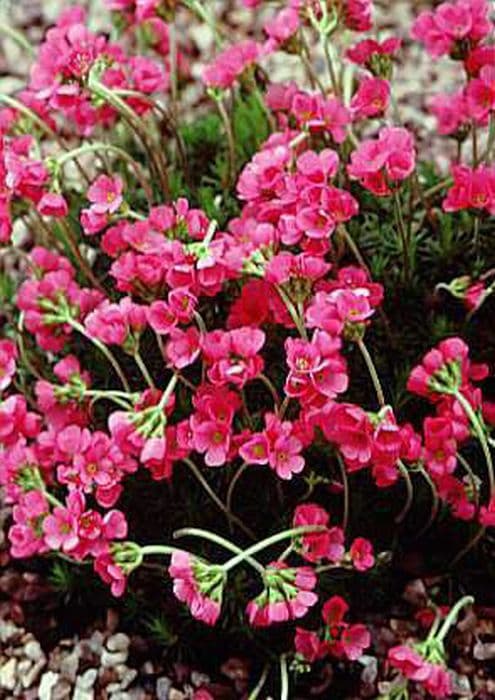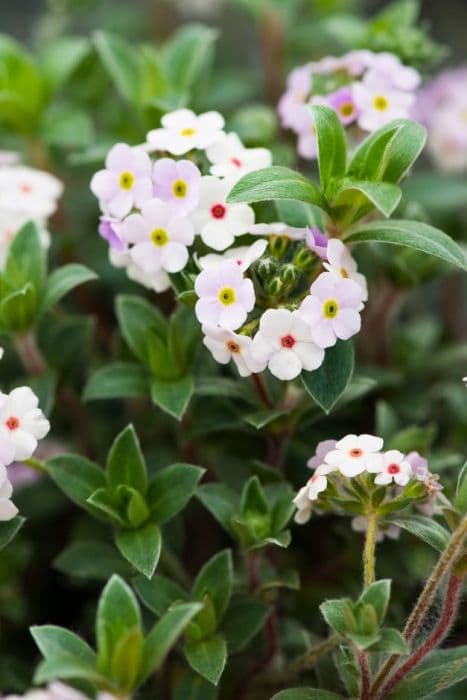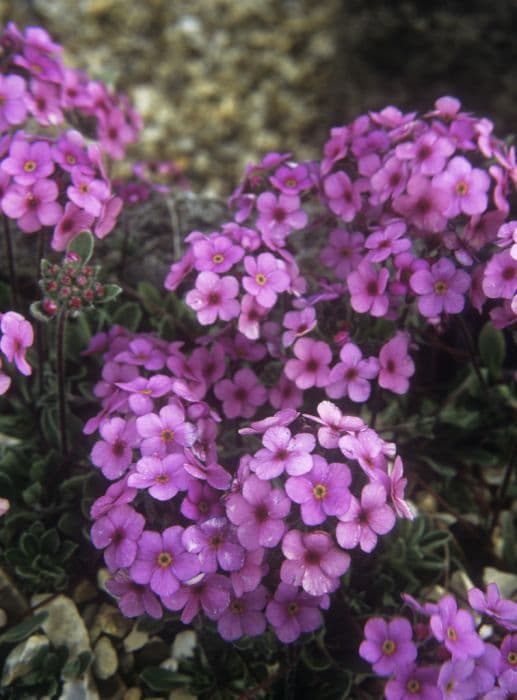Auricula Primula auricula 'Sirius' (Au/a)

ABOUT
Primula auricula 'Sirius', commonly referred to as auricula, bears a striking appearance that draws plant enthusiasts and gardeners. The plant showcases a rosette formation comprising spoon-shaped, fleshy leaves that give it a lush, robust look. The leaves often have a unique powdery coating, granting them a slightly greyish or bluish tinge, depending on the light. Standing out against this backdrop are the flowers, which are a vibrant and deep shade, encircled by a ring of contrasting hue that makes them pop visually. Each flower possesses a round, almost velvety appearance, with a texture that suggests a richness to their form. The bold and brilliant blossoms emerge in clusters atop sturdy stalks that rise from the plant's center, creating a dazzling display of color that is both alluring and delicate. The auricula is admired for this floral show, which is a hallmark of the Primula family's undeniable charm.
About this plant
 Names
NamesFamily
Primulaceae
Synonyms
Bear's Ear, Mountain Cowslip, Auricula
Common names
Primula auricula 'Sirius'
 Toxicity
ToxicityTo humans
The Bear's Ear, the common name for Primula auricula 'Sirius', is generally considered not toxic to humans. However, some individuals may experience contact dermatitis or skin irritation from handling the plant, due to the presence of primin, a compound found in the plant's foliage and sap. Ingesting parts of the plant is not commonly associated with poisoning, and it is not considered a toxic plant to humans in the culinary sense. As with any non-food plant, ingestion in large quantities could potentially cause stomach upset or discomfort, but this is not common.
To pets
The Bear's Ear, the common name for Primula auricula 'Sirius', is not known for being toxic to pets such as dogs and cats. While the plant is not considered poisonous, ingestion of large amounts could potentially lead to mild gastrointestinal upset, as is typical with the ingestion of non-digestible plant material. However, there are no specific toxic compounds known in Bear's Ear that would cause poisoning symptoms in pets. It is always best to prevent pets from eating ornamental plants, as individual animals may have varying sensitivities.
 Characteristics
CharacteristicsLife cycle
Perennials
Foliage type
Evergreen
Color of leaves
Green
Flower color
Yellow
Height
6 inches (15 cm)
Spread
6 inches (15 cm)
Plant type
Herb
Hardiness zones
5
Native area
Europe
Benefits
 General Benefits
General Benefits- Aesthetic Appeal: Adds vibrant colors to gardens with its striking flowers.
- Easy to Grow: Known for being low-maintenance and suitable for beginner gardeners.
- Attracts Wildlife: Can attract pollinators such as bees and butterflies, which benefits the ecosystem.
- Compact Size: Ideal for small spaces or as part of a container garden due to its modest size.
- Versatility: Suitable for rock gardens, borders, and alpine houses, offering various landscaping options.
- Seasonal Interest: Blooms in spring, providing early seasonal interest in the garden.
- Hardiness: Resilient to cooler temperatures and can withstand frost, making it suitable for diverse climates.
 Medical Properties
Medical PropertiesThis plant is not used for medical purposes.
 Air-purifying Qualities
Air-purifying QualitiesThis plant is not specifically known for air purifying qualities.
 Other Uses
Other Uses- Auricula 'Sirius' flowers can be crystallized and used to decorate cakes and desserts, offering a unique and edible embellishment.
- The blossoms of Auricula 'Sirius' can be incorporated into potpourris for a subtle, natural fragrance in the home.
- Leaves of Auricula 'Sirius' can be used to create natural dyes for fabrics, producing a range of colours depending on the mordant used.
- The blooms can be pressed and included in resin jewelry, capturing their beauty in pendants, earrings, and other adornments.
- Auricula 'Sirius' can be grown for competitive showing in Auricula Theatres, which are traditional display cases for these plants dating back to the Victorian era.
- Petals from Auricula 'Sirius' can be included in handmade papers, giving it a decorative and textured look.
- The plant can be used as a living gift, representing a unique and collectible variety for garden enthusiasts and plant collectors.
- Flowers can be used in the crafting of natural confetti for eco-friendly celebrations, as they are biodegradable and add a colorful touch.
- Auricula 'Sirius' can serve as an inspiration for artists and photographers, capturing the unique patterns and colors of the flowers in their work.
- The plant can be cultivated to contribute to biodiversity in gardens, especially in urban environments where variety in flora is essential for supporting local ecosystems.
Interesting Facts
 Feng Shui
Feng ShuiThe Auricula is not used in Feng Shui practice.
 Zodiac Sign Compitability
Zodiac Sign CompitabilityThe Auricula is not used in astrology practice.
 Plant Symbolism
Plant Symbolism- Unique Beauty: The Primula auricula 'Sirius', commonly known as Auricula, has distinctive and unusual patterns, symbolizing unique beauty and individualism.
- Rarity: Auriculas are prized by collectors for their rarity and diverse forms, making them a symbol of rarity and exclusivity.
- Perseverance: Given their ability to thrive in alpine regions, they represent resilience and the ability to persevere through challenging conditions.
- Cherished Friendship: Historically, auriculas were often exchanged between friends, symbolizing a treasured and cherished friendship.
- Patrician Pride: In the Victorian language of flowers, the auricula was a plant often associated with pride due to its stately appearance and the pride collectors took in owning rare varieties.
 Water
WaterAuricula, commonly known as Bear's Ear, should be watered thoroughly, allowing the water to reach deep into the root system without leaving the plant sitting in water. Generally, Bear's Ear should be watered once a week, but this frequency may need to be adjusted depending on the climate and season; during hot, dry periods, you may need to water it more often. Provide about 8-16 ounces of water for smaller pots or up to 1-2 gallons for larger pots, each time you water, ensuring the soil is moist but not waterlogged. It's best to check the soil moisture level before watering; the top inch should be dry to the touch.
 Light
LightBear's Ear thrives in bright, indirect light, and should be placed in a location where it receives this type of light for most of the day. A north-facing or east-facing window can be the ideal spot, as it will receive the morning sunlight but be protected from the harsh midday and afternoon sun, which can scorch the leaves.
 Temperature
TemperatureBear's Ear prefers cooler temperatures, with an ideal range between 50 to 70 degrees Fahrenheit. Although it can survive temperatures down to 30 degrees Fahrenheit for brief periods, prolonged exposure to cold beyond this point can damage the plant. Similarly, temperatures exceeding 80 degrees Fahrenheit can stress the plant, so it's best to keep it in conditions that avoid temperature extremes.
 Pruning
PruningPruning Bear's Ear is important for removing dead or yellowing leaves and spent flowers to encourage new growth and maintain a tidy appearance. Light pruning can be done throughout the growing season as needed, while more thorough trimming is best performed in late winter or early spring before new growth begins. Cutting back the foliage after flowering also helps to stimulate a second bloom.
 Cleaning
CleaningAs needed
 Soil
SoilAuricula Primrose, commonly known as Auricula, flourishes best in sharply draining soil with a slight bias towards alkalinity, with a pH around 6.0 to 7.5. A suitable soil mix consists of one part loam, one part peat-free compost, and one part perlite or grit to ensure good drainage and aeration.
 Repotting
RepottingAuricula Primrose should be repotted every one to two years. This helps to refresh the soil and maintain nutrient levels, ensuring the plant remains healthy. However, they can be left undisturbed if they are thriving and flowering well.
 Humidity & Misting
Humidity & MistingAuricula Primrose prefers moderate humidity and does not tolerate overly damp environments, which can lead to fungal diseases. Aim for a humidity level around 50-60% for optimal growth conditions.
 Suitable locations
Suitable locationsIndoor
Keep Auricula in bright, indirect light with good ventilation.
Outdoor
Plant in partial shade, shelter from harsh elements.
Hardiness zone
4-8 USDA
 Life cycle
Life cyclePrimula auricula 'Sirius', commonly known as Auricula, begins its life cycle as a seed, which when sown in fertile, well-draining soil and provided with appropriate light and moisture, will germinate and grow into a seedling. The seedling stage involves the development of a basic root system and the first true leaves. As it matures, the plant enters a vegetative growth phase, establishing a more robust root system, and producing a rosette of thicker, fleshier leaves typical of Auriculas. The plant will then enter the flowering stage, producing striking, often brightly colored and patterned flowers that can attract pollinators, leading to potential cross-pollination. After pollination, Auricula will set seed, completing the life cycle as these seeds can be collected for propagation or will fall to the ground to potentially germinate anew. In well-maintained conditions, Auriculas can be perennial, continuing their life cycle for several years by undergoing seasonal dormancy and regrowth.
 Propogation
PropogationPropogation time
Spring to Summer
Primula auricula 'Sirius', commonly known as auricula or bear's ear, is a plant that is often propagated by division. The best time to carry out this method is in late summer, after the flowering period has concluded, when the plant is not actively growing. Division involves gently separating the plant into smaller sections, ensuring that each section has a portion of the root system as well as several leaves or growth points. This can be easily done by removing the plant from its pot or location in the garden and carefully breaking apart the clumps with your hands or by using a knife for tougher roots. The new divisions should then be planted in a mix of compost and grit to ensure good drainage, at a depth where the crown of the plant is just above the soil surface, and they should be watered in well. After potting, the divisions should be kept shaded and moist until they establish and resume growth.









